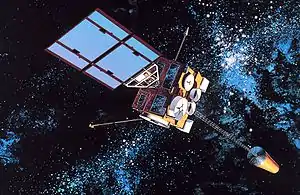 Artist's impression of an HS-371-derived GOES satellite | |
| Mission type | Weather satellite |
|---|---|
| Operator | NOAA / NASA |
| Mission duration | Failed to orbit 7 years (planned) |
| Spacecraft properties | |
| Bus | HS-371 |
| Manufacturer | Hughes |
| Launch mass | 660 kilograms (1,460 lb) |
| Start of mission | |
| Launch date | 3 May 1986, 22:18 UTC[1] |
| Rocket | Delta 3914 D178 |
| Launch site | Cape Canaveral LC-17A |
| Contractor | McDonnell Douglas |
| Orbital parameters | |
| Reference system | Geocentric |
| Regime | Geostationary |
| Epoch | Planned |
GOES-G was a weather satellite to be operated by the National Oceanic and Atmospheric Administration. The satellite was designed to sense and monitor meteorological conditions from a geostationary orbit, intended to replace GOES-5 and provide continuous vertical profiles of atmospheric temperature and moisture. It was lost due to the launch failure of a Delta 3914 rocket on 3 May 1986.
Launch

GOES-G launch.

Explosion 71 seconds after launch.
Launch occurred on May 3, 1986 at 22:18 GMT,[2] aboard Delta 178, the first NASA launch following the Challenger disaster. Seventy-one seconds into the flight, the first stage RS-27 engine shut down prematurely due to an electrical fault, and the rocket was destroyed by range safety.[3][4]
References
- ↑ McDowell, Jonathan. "Launch Log". Jonathan's Space Page. Retrieved December 23, 2009.
- ↑ Encyclopedia Astronautica – Delta Archived August 17, 2013, at the Wayback Machine
- ↑ Savage, Annaliza (November 19, 2009). "When Good Rockets Go Bad". Wired. ISSN 1059-1028. Retrieved June 22, 2020.
- ↑ Kyle, Ed. "Delta Reborn: Extra Extended Long Tank "Delta 2"". www.spacelaunchreport.com. Retrieved June 22, 2020.
External links
This article is issued from Wikipedia. The text is licensed under Creative Commons - Attribution - Sharealike. Additional terms may apply for the media files.
